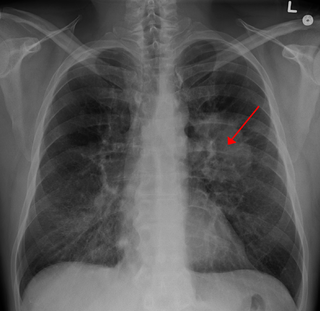
Lung cancer, also known as bronchial carcinoma, since about 98–99% of all lung cancers are carcinomas, is a malignant lung tumor characterized by uncontrolled cell growth in tissues of the lung. Lung carcinomas derive from transformed, malignant cells that originate as epithelial cells, or from tissues composed of epithelial cells. Other lung cancers, such as the rare sarcomas of the lung, are generated by the malignant transformation of connective tissues, which arise from mesenchymal cells. Lymphomas and melanomas can also rarely result in lung cancer.

Radiation therapy or radiotherapy, often abbreviated RT, RTx, or XRT, is a therapy using ionizing radiation, generally provided as part of cancer treatment to control or kill malignant cells and normally delivered by a linear accelerator. Radiation therapy may be curative in a number of types of cancer if they are localized to one area of the body. It may also be used as part of adjuvant therapy, to prevent tumor recurrence after surgery to remove a primary malignant tumor. Radiation therapy is synergistic with chemotherapy, and has been used before, during, and after chemotherapy in susceptible cancers. The subspecialty of oncology concerned with radiotherapy is called radiation oncology. A physician who practices in this subspecialty is a radiation oncologist.

Tumor hypoxia is the situation where tumor cells have been deprived of oxygen. As a tumor grows, it rapidly outgrows its blood supply, leaving portions of the tumor with regions where the oxygen concentration is significantly lower than in healthy tissues. Hypoxic microenvironements in solid tumors are a result of available oxygen being consumed within 70 to 150 μm of tumour vasculature by rapidly proliferating tumor cells thus limiting the amount of oxygen available to diffuse further into the tumor tissue. In order to support continuous growth and proliferation in challenging hypoxic environments, cancer cells are found to alter their metabolism. Furthermore, hypoxia is known to change cell behavior and is associated with extracellular matrix remodeling and increased migratory and metastatic behavior.

Glioblastoma, also known as glioblastoma multiforme (GBM), is the most aggressive type of cancer that begins within the brain. Initially, signs and symptoms of glioblastoma are nonspecific. They may include headaches, personality changes, nausea, and symptoms similar to those of a stroke. Symptoms often worsen rapidly and may progress to unconsciousness.

Dactinomycin, also known as actinomycin D, is a chemotherapy medication used to treat a number of types of cancer. This includes Wilms tumor, rhabdomyosarcoma, Ewing's sarcoma, trophoblastic neoplasm, testicular cancer, and certain types of ovarian cancer. It is given by injection into a vein.

Tirapazamine (SR-4233) is an experimental anticancer drug that is activated to a toxic radical only at very low levels of oxygen (hypoxia). Such levels are common in human solid tumors, a phenomenon known as tumor hypoxia. Thus, tirapazamine is activated to its toxic form preferentially in the hypoxic areas of solid tumors. Cells in these regions are resistant to killing by radiotherapy and most anticancer drugs. Thus the combination of tirapazamine with conventional anticancer treatments is particularly effective. As of 2006, tirapazamine is undergoing phase III testing in patients with head and neck cancer and gynecological cancer, and similar trials are being undertaken for other solid tumor types.

Crocetin is a natural apocarotenoid dicarboxylic acid that is found in the crocus flower and Gardenia jasminoides (fruits). It forms brick red crystals with a melting point of 285°C.

Mucoepidermoid carcinoma (MEC) is the most common type of minor salivary gland malignancy in adults. Mucoepidermoid carcinoma can also be found in other organs, such as bronchi, lacrimal sac, and thyroid gland.

EF5 is a nitroimidazole derivative used in oncology research. Due to its similarity in chemical structure to etanidazole, EF5 binds in cells displaying hypoxia.
Signal interfering DNA (siDNA) is a class of short modified double stranded DNA molecules, 8–64 base pairs in length. siDNA molecules are capable of inhibiting DNA repair activities by interfering with multiple repair pathways. These molecules are known to act by mimicking DNA breaks and interfering with recognition and repair of DNA damage induced on chromosomes by irradiation or genotoxic products.
The Danish Head and Neck Cancer (DAHANCA) group was established in 1976 as a working group by the Danish Society for Head and Neck Oncology with the primary aim to develop national guidelines for the treatment of head and neck cancer in Denmark.

Lonidamine is a derivative of indazole-3-carboxylic acid, which for a long time, has been known to inhibit aerobic glycolysis in cancer cells. It seems to enhance aerobic glycolysis in normal cells, but suppress glycolysis in cancer cells. This is most likely through the inhibition of the mitochondrially bound hexokinase. Later studies in Ehrlich ascites tumor cells showed that lonidamine inhibits both respiration and glycolysis leading to a decrease in cellular ATP.

A radiosensitizer is an agent that makes tumor cells more sensitive to radiation therapy. It is sometimes also known as a radiation sensitizer or radio-enhancer.

PARP inhibitors are a group of pharmacological inhibitors of the enzyme poly ADP ribose polymerase (PARP).

Targeted intra-operative radiotherapy, also known as targeted IORT is a technique of giving radiotherapy to the tissues surrounding a cancer after its surgical removal, a form of intraoperative radiation therapy. The technique was designed in 1998 at the University College London. In patients having lumpectomy for breast cancer, the TARGIT-A(lone) randomized controlled trial tested whether TARGIT within a risk-adapted approach is non-inferior to conventional course of external beam postoperative radiotherapy given over several weeks.

Etanidazole is a nitroimidazole drug that was investigated in clinical trials for its radiosensitizing properties in cancer treatment. Administration of etanidazole results in a decrease of glutathione concentration and inhibits glutathione S-transferase. The result is that tissues become more sensitive to the ionizing radiation.

Osteoradionecrosis (ORN) is a serious complication of radiation therapy in cancer treatment where radiated bone becomes necrotic and exposed. ORN occurs most commonly in the mouth during the treatment of head and neck cancer, and can arise over 5 years after radiation. Common signs and symptoms include pain, difficulty chewing, trismus, mouth-to-skin fistulas and non-healing ulcers.

18F-FMISO or fluoromisonidazole is a radiopharmaceutical used for PET imaging of hypoxia. It consists of a 2-nitroimidazole molecule labelled with the positron-emitter fluorine-18.
Sandro Porceddu is a head and neck radiation oncologist at Brisbane's Princess Alexandra Hospital and a Professor with the University of Queensland. He was president of the Clinical Oncologic Society of Australia (COSA) and chair of the Trials Scientific Committee of the Trans Tasman Radiation Oncology Group (TROG).
In biochemistry, the oxygen effect refers to a tendency for increased radiosensitivity of free living cells and organisms in the presence of oxygen than in anoxic or hypoxic conditions, where the oxygen tension is less than 1% of atmospheric pressure.
















